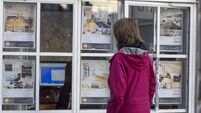Easing of house price growth may be offset by soaring building costs

Just under 7,000 housing units began construction in the first three months of this year, 143% more than in the first quarter of Q1 2021. File Picture: Denis Minihane
The increasing supply of new homes may be easing the growth in prices but this could be offset by the continued rise in the cost of construction materials, Ireland's banking industry has warned.
While property prices nationally have more than doubled from their low in early 2013, the latest Housing Market Monitor by Banking & Payments Federation Ireland (BPFI) shows that the rate of increase in the average price of a home has been declining on a monthly basis since the middle of last year.
The BPFI said this easing may be down to the significant increase in the number of new homes coming on the market and said there was a strong pipeline of homes expected over the coming two years due to increased levels of construction activity.
Just under 7,000 housing units began construction in the first three months of this year, 143% more than in the first quarter of Q1 2021. In the same period, 5,669 completed construction, up by 44.5% compared to 2021.
Brian Hayes, BPFI Chief Executive, said prices in the Irish residential property market have been driven mostly by the lack of supply in the market.
"While house prices are continuing to rise, the rate of that increase may now be easing as housing supply also increases," he said. "Figures show the rate of increase in average property prices has been declining on a monthly basis since the middle of last year, which may reflect increasing housing supply."
On an annualised basis, more than 34,800 units began construction in the 12 months ending March 2022, the most since the 12 months ending June 2008. Mr Hayes said this was a healthy sign of the pipeline for completions.
"Notwithstanding the fact that apartments account for an increasing share of housing output and these take longer than houses to complete, we should see a significant increase in the number of units completed in the second quarter of 2022. This increase in supply should help to alleviate some of the pressure on average prices."
However, the analysis from the BPFI warned that the ongoing increases in construction materials and labour costs could offset any gains from increased supply.
The most recent BNP Paribas Real Estate Construction Purchasing Managers Index shows that cost pressures were severe in April, the second-fastest rise in input prices since the survey began in June 2000.
Annual inflation for building and construction materials was running at 18.2% in April, while annual inflation for some materials such as metal and wood ranged between 50% and 60%. In addition, preliminary estimates from the CSO show that average hourly total labour costs increased by 15.2% in the construction sector during the first quarter of 2021.
Mr Hayes said it will be crucial to analyse cost challenges in the construction sector and minimise the impact of building cost inflation on home prices.
"While building more homes in order to try meet required demand, it will be important to scrutinise cost increases in the sector and, where possible, minimise the impact of building cost inflation on home prices," he said.















